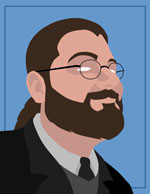I grew up an only child in a big old farmhouse in the middle of nowhere, Ohio. I had parents that liked to read, and our house was always littered with books and magazines. Figuring out where my love for books came from isn’t exactly rocket science.
Influences
I still remember vividly some of the books that really made an impact on me when I was kid. Franklin W. Dixon’s Hardy Boys Mysteries were huge for me, as were The Three Investigators books and the wonderfully moody The House with the Clock in Its Walls, although whether I was more impressed by John Bellairs’ text or Edward Gorey’s amazing illustrations is a tough call. I was also an absolute fiend when it came to mythology, ghost stories and cryptozoology. I was the kind of dork who was more than happy to stay in from recess and read, or work on the school newspaper.
Like many writer-designers, I’ve also enjoyed comics for years. Not so much the Superman/X-Men scene (although there’s been a little of that), but more the Sandman/Transmetropolitan/Bone scene. I’m a sucker for stories about old gods stumbling around lost in the here and now.
I’m also a huge sucker for magical realism. Gabriel Garcia Marquez, Jorge Luis Borges, Jonathan Carroll, Italo Calvino, Louis de Bernieres… Any time a truly excellent writer uses fantastic elements to illustrate either sweeping concepts or the nuances of life, I’m interested.
Literary versus enjoyable
My attitude towards literature is simple: make it good, and make it fun. In my opinion, “literary” writing that isn’t any fun to read is, nine times out of ten, a waste of the reader’s time. If you want to write it for yourself, that’s great – here’s your diary. Just don’t expect me to be interested.
I created Inkblots in late 1994 for several reasons. First, my high school didn’t have a literary magazine, and the principal balked when he found out my proposal was very firmly against censorship. Second, I wanted to create a literary magazine that would contain more vibrant, interesting stuff than what the literary snobs were cranking out. I wanted to do a magazine about literature, culture, and even technology. I wanted to do the Rolling Stone of literary magazines, something that your average not-a-moron would actually enjoy reading. The formula worked: by the time I retired the magazine when I graduated in 1996, we were shipping copies overseas. It was great.
When I entered Kenyon College in the fall of ’96, I did so with one goal in mind: to study writing. I struggled with a lot of people whose attitude towards writing differed greatly from my own, but I also found a lot of allies. Even better, while at Kenyon I also discovered digital storytelling.
Since then, I’ve been studying different ways to use new technology to tell stories. This website is an extension of those studies, as is the online version of Inkblots. I’m planning to keep adding new experiments and works to this site as often as I can, so please stay tuned.


